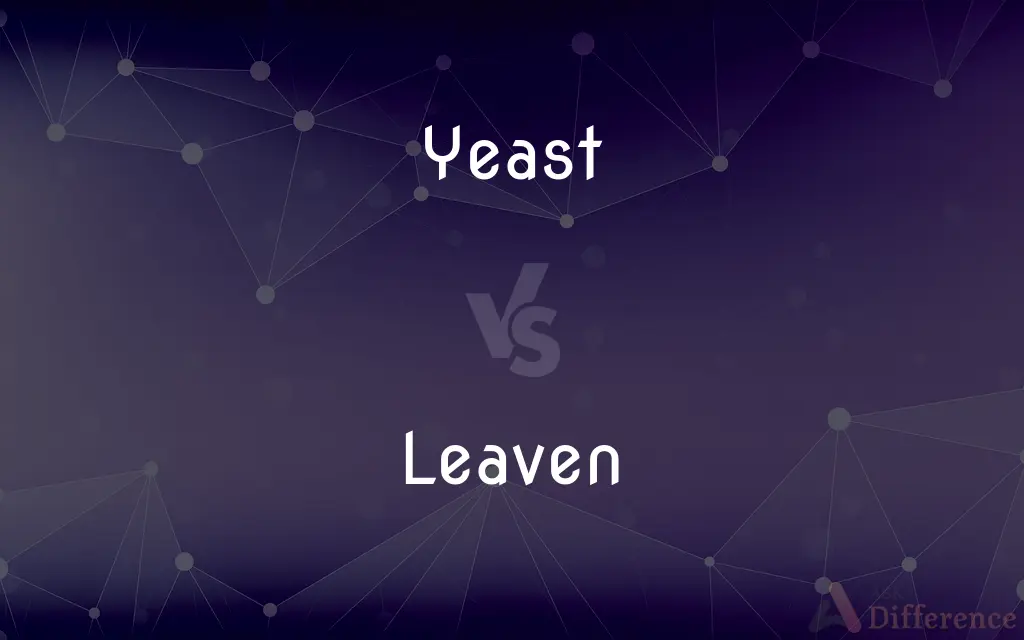Yeast vs. Leaven — What's the Difference?
By Fiza Rafique & Urooj Arif — Updated on March 28, 2024
Yeast is a microorganism used in fermentation, whereas leaven refers to any agent causing dough to rise.

Difference Between Yeast and Leaven
Table of Contents
ADVERTISEMENT
Key Differences
Yeast is a single-celled fungus that plays a crucial role in the fermentation process, converting sugars into alcohol and carbon dioxide. This process is essential in bread making, brewing, and winemaking. Yeast not only contributes to the rise of the dough but also impacts the flavor and texture of the final product. On the other hand, leaven encompasses a broader range of substances, including yeast, baking soda, baking powder, and sourdough starters, that cause dough or batter to rise. While yeast works through fermentation, other leavening agents may rely on chemical reactions or physical processes to produce gas.
Yeast's activity in dough is dependent on temperature, hydration, and food source (sugars), with optimal conditions leading to effective fermentation and gas production. This process not only leavens bread but also develops its flavor and texture. Leaven, in its various forms, may operate differently; for example, chemical leaveners like baking powder release gas upon contact with moisture and heat, causing the dough to expand rapidly without the need for fermentation time.
The choice between yeast and other forms of leaven depends on the desired outcome. Yeast-leavened breads, such as sourdough or brioche, are noted for their complex flavors and textures, developed over longer fermentation periods. In contrast, quick breads and cakes, which often use baking powder or soda, are prized for their speedy preparation and lighter, more uniform crumb.
Yeast can also be used in non-baking contexts, such as in the production of alcoholic beverages, where it ferments sugars to produce alcohol and carbon dioxide. This versatility contrasts with other leavening agents, which are primarily used in baking and have limited applications outside of it.
Despite their differences, both yeast and other leavening agents play vital roles in culinary arts, each contributing unique qualities to various dishes. Understanding their distinct properties and applications can enhance the quality and variety of foods prepared.
ADVERTISEMENT
Comparison Chart
Definition
A single-celled fungus used in fermentation, particularly in baking and brewing.
Any agent that causes dough or batter to rise, including yeast, baking soda, and baking powder.
Process
Fermentation, converting sugars into alcohol and carbon dioxide.
Can involve fermentation or chemical reactions, depending on the agent.
Applications
Bread making, brewing, winemaking.
Bread making, baking cakes and quick breads.
Flavor Contribution
Can impart distinctive flavors to bread and alcoholic beverages.
May not significantly alter flavor, especially chemical leaveners.
Preparation Time
Longer, due to fermentation.
Can be instant or require less time, especially with chemical leaveners.
Compare with Definitions
Yeast
Yeast contributes to the flavor and texture of baked goods.
Sourdough bread's unique taste comes from the fermentation process driven by yeast.
Leaven
Chemical leavens produce gas through chemical reactions.
When baking soda reacts with an acid, it releases carbon dioxide, leavening the dough.
Yeast
Yeast is essential for fermentation, producing alcohol and carbon dioxide.
In brewing, yeast is added to wort to ferment the sugars into alcohol.
Leaven
The choice of leaven affects the texture and preparation time of baked goods.
Quick breads use baking powder for immediate leavening, unlike yeast breads.
Yeast
Yeast comes in various forms, including fresh, dry, and instant.
Instant yeast can be mixed directly into flour, simplifying the baking process.
Leaven
Leaven refers to any substance that causes dough to rise, including yeast.
Baking powder is a common leavening agent used in cakes.
Yeast
Yeast is a microorganism used in baking and brewing.
Yeast ferments sugars in the dough, causing bread to rise.
Leaven
Leaven can be biological, like yeast, or chemical, like baking powder.
Sourdough starters leaven bread through natural yeast and bacterial activity.
Yeast
Yeast requires warm temperatures and a food source to be active.
Yeast is activated in warm water with sugar before being added to flour.
Leaven
Some leavens, like sourdough starter, can be cultivated at home.
A sourdough starter is maintained with regular feedings of flour and water.
Yeast
Yeasts are eukaryotic, single-celled microorganisms classified as members of the fungus kingdom. The first yeast originated hundreds of millions of years ago, and at least 1,500 species are currently recognized.
Leaven
Cause to puff up with a leaven;
Unleavened bread
Yeast
A microscopic fungus consisting of single oval cells that reproduce by budding, and capable of converting sugar into alcohol and carbon dioxide.
Leaven
An agent, such as yeast, that causes batter or dough to rise, especially by fermentation.
Yeast
Any of numerous fungi that exhibit a one-celled growth form and reproduce by budding, including certain candidas that can cause infections in humans.
Leaven
An element, influence, or agent that works subtly to lighten, enliven, or modify a whole.
Yeast
Froth consisting of yeast cells together with the carbon dioxide they produce in the process of fermentation, present in or added to fruit juices and other substances in the production of alcoholic beverages.
Leaven
To add a rising agent to.
Yeast
A powdered or compressed commercial preparation of yeast cells, used chiefly as a leavening agent or as a dietary supplement.
Leaven
To cause to rise, especially by fermentation.
Yeast
An agent of ferment or activity
Political agitators who are the yeast of revolution.
Leaven
To pervade with a lightening, enlivening, or modifying influence.
Yeast
An often humid, yellowish froth produced by fermenting malt worts, and used to brew beer, leaven bread, and also used in certain medicines.
Leaven
Any agent used to make dough rise or to have a similar effect on baked goods.
Yeast
A single-celled fungus of a wide variety of taxonomic families.
Leaven
(figurative) Anything that induces change, especially a corrupting or vitiating change.
Yeast
A true yeast or budding yeast in order Saccharomycetales.
Leaven
(transitive) To add a leavening agent.
Yeast
Candida, a ubiquitous fungus that can cause various kinds of infections in humans.
Leaven
(transitive) To cause to rise by fermentation.
Yeast
(figuratively) A frothy foam.
Leaven
To temper an action or decision.
Yeast
To ferment.
Leaven
To imbue; to infect; to vitiate.
Yeast
(of something prepared with a yeasted dough) To rise.
Leaven
To rise or become larger. en
Yeast
To exaggerate.
Leaven
Any substance that produces, or is designed to produce, fermentation, as in dough or liquids; esp., a portion of fermenting dough, which, mixed with a larger quantity of dough, produces a general change in the mass, and renders it light; yeast; barm.
Yeast
The foam, or troth (top yeast), or the sediment (bottom yeast), of beer or other in fermentation, which contains the yeast plant or its spores, and under certain conditions produces fermentation in saccharine or farinaceous substances; a preparation used for raising dough for bread or cakes, and making it light and puffy; barm; ferment.
Leaven
Anything which makes a general assimilating (especially a corrupting) change in the mass.
Beware of the leaven of the Pharisees, which is hypocrisy.
Yeast
Spume, or foam, of water.
They melt thy yeast of waves, which marAlike the Armada's pride, or spoils of Trafalgar.
Leaven
To make light by the action of leaven; to cause to ferment.
A little leaven leaveneth the whole lump.
Yeast
A form of fungus which grows as individual rounded cells, rather than in a mycelium, and reproduces by budding; esp. members of the orders Endomycetales and Moniliales. Some fungi may grow both as a yeast or as a mycelium, depending on the conditions of growth.
Leaven
To imbue; to infect; to vitiate.
With these and the like deceivable doctrines, he leavens also his prayer.
Yeast
A commercial leavening agent containing yeast cells; used to raise the dough in making bread and for fermenting beer or whiskey
Leaven
A substance used to produce fermentation in dough or a liquid
Leaven
An influence that works subtly to lighten or modify something;
His sermons benefited from a leavening of humor
Common Curiosities
What are examples of leavening agents?
Besides yeast, baking soda, baking powder, and sourdough starters are common leavening agents.
How does yeast work?
Yeast ferments sugars present in the dough, producing carbon dioxide that causes the dough to expand and rise.
What is yeast?
Yeast is a fungus that facilitates fermentation, converting sugars into alcohol and carbon dioxide, commonly used in baking and brewing.
What does leaven mean?
Leaven refers to any agent that causes dough or batter to rise, which can be biological like yeast or chemical like baking powder.
Why is fermentation time important in yeast-leavened bread?
Fermentation time allows yeast to develop the dough's flavor and structure, leading to a more complex taste and texture.
Can yeast be used in cakes?
While yeast can be used in cakes, it's more common to use faster-acting chemical leavening agents like baking powder.
Is sourdough bread made with yeast or another leaven?
Sourdough bread uses a natural leaven, which includes wild yeast and bacteria, for fermentation.
What is the difference between active dry yeast and instant yeast?
Active dry yeast needs to be dissolved in water before use, whereas instant yeast can be mixed directly with dry ingredients.
Are there health benefits to using yeast in baking?
Yes, yeast-leavened breads can have digestive benefits and nutrients from the fermentation process.
Can leavening agents affect the flavor of baked goods?
Yes, especially yeast, which can impart a distinct flavor through fermentation, unlike most chemical leaveners.
What role does temperature play in yeast fermentation?
Optimal temperature is crucial for yeast activity, promoting efficient fermentation and gas production.
How can one make homemade leaven?
A sourdough starter, made from flour and water, can be cultivated at home to serve as a natural leaven.
How do baking soda and baking powder differ in leavening?
Baking soda requires an acid to activate, while baking powder contains both an acid and a base, reacting with moisture and heat.
Share Your Discovery

Previous Comparison
Bitter vs. Cable
Next Comparison
Studio vs. BedsitAuthor Spotlight
Written by
Fiza RafiqueFiza Rafique is a skilled content writer at AskDifference.com, where she meticulously refines and enhances written pieces. Drawing from her vast editorial expertise, Fiza ensures clarity, accuracy, and precision in every article. Passionate about language, she continually seeks to elevate the quality of content for readers worldwide.
Co-written by
Urooj ArifUrooj is a skilled content writer at Ask Difference, known for her exceptional ability to simplify complex topics into engaging and informative content. With a passion for research and a flair for clear, concise writing, she consistently delivers articles that resonate with our diverse audience.















































